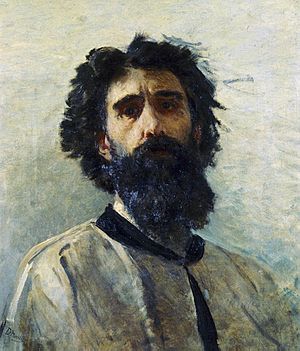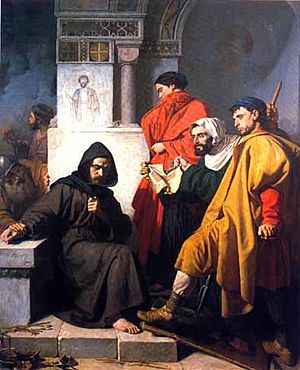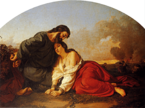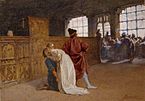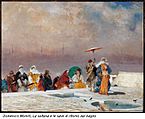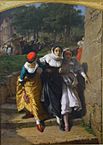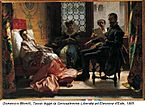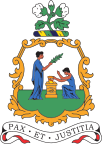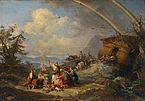Domenico Morelli facts for kids
Domenico Morelli (born August 4, 1823 – died August 13, 1901) was a very important Italian painter. He mostly created paintings about history and religious stories. Morelli had a huge impact on art in the late 1800s. He was the director of the Academy of Fine Arts in Naples. He was also known for his rebellious spirit against old art rules. This led to his passionate and often patriotic paintings, first in the Romantic style, and later in the Symbolist style. Morelli taught many students, including Vincenzo Petrocelli and Ulisse Caputo.
Contents
Morelli's Early Life and Art
Domenico Morelli was born into a poor family in Naples. His mother hoped he would become a priest. But he showed amazing talent for art from a young age. Because of this, he joined the Royal Academy of Fine Arts in Naples in 1836. He studied there until 1846. During this time, he became good friends with Francesco Saverio Altamura.
His first paintings often showed scenes from Medieval stories and poems by Romantic poets like Byron. In 1845, he won a prize for his painting L' angelo che porta le anime al Purgatorio dantesco (The Angel Carrying Souls to Dante's Purgatory). With help from a generous lawyer named Ruggiero, he won a scholarship to study in Rome. This was after he painted Saul calmato da David (Saul Calmed by David) in 1845–46.
While in Rome, from 1847 to 1848, he painted several works. These included Il corsaio (The Corsair), Una sfida di Trovatori (A Challenge of Troubadours), and the prize-winning Bacio del Corsaro (Kiss of the Corsair). He also painted Goffredo a cui appare l'angelo (Godfrey to Whom the Angel Appears). In 1847, he created Madonna che culla il bambino, aiutata da San Giovanni (Madonna Cradling the Child, Helped by Saint John).
Morelli's Role in the 1848 Revolutions
Morelli had just returned to Naples when the uprisings of 1848 began. He joined the people protesting on the streets. He was wounded and almost died, and was even put in prison for a short time. After he died, a writer named Isabella Anderton called Domenico one of Italy's "warrior artists." This group also included famous painters like Filippo Palizzi and Francesco Saverio Altamura.
After being released from prison, Morelli went back to Rome. There, he painted Van der Welt in mezzo ai corsari sopra una via romita (Van der Welt Among the Corsairs on a Solitary Road) in 1851. He also painted Cesare Borgia a Capita in mezzo ad una folla di fanciulle (Cesare Borgia at Capita Among a Crowd of Girls).
Developing His Artistic Style
In 1855, Morelli showed his famous painting The Iconoclasts at an exhibition in Florence. He also took part in the Universal Exposition in Paris that same year. Later, in Florence, he was very active in discussions with the Macchiaioli artists. This group focused on Realism, which meant painting things as they truly looked.
Morelli said that these discussions helped his own work become less formal and more free. He began to experiment more with colors. During this time, his art was considered part of the Realism movement.
In 1857, he won a competition to design decorations for the church of San Francesco in Gaeta. However, this project was never finished. On a trip to Milan, he painted Count di Ijara, Pompeian Bath, and a Madonna Addolorata (Sorrowful Madonna). By 1857, he was back in Naples, where he painted Torquato Tasso. He also painted an Assumption of the Virgin for the ceiling of the Royal chapel of Naples.
Later Career and Influence
Morelli was part of an independent group called the Societa Promotrice in 1862. This group, led by his friend Filippo Palizzi, worked to support the arts. Morelli was also chosen to advise on new art purchases for the Capodimonte art museum in Naples. This gave him a big role in shaping the museum's collections.
In 1868, Morelli became a professor of painting at his old Academy, which was now called the Royal Institute of Fine Arts in Naples. From this point on, he became more interested in religious and mystical themes. He drew inspiration from Christian, Jewish, and Muslim traditions. One of his most famous works from this time is the Assumption on the ceiling of the Royal Palace in Naples. Morelli also helped create illustrations for the Amsterdam Bible in 1895. From 1899 until his death, he was the president of the Royal Academy of Fine Arts in Naples.
Late in his life, Morelli received many awards and honors. He was made an honorary professor at major academies across Italy and Europe. He also received important knighthoods, including the Order of SS. Maurizio e Lazzaro and the Order of the Crown of Italy. In June 1886, the King made him a senator.
Domenico Morelli passed away on August 13, 1901, in Naples.
Many artists were taught by Morelli. Some of his notable students included Giuseppe Costa, Francesco Paolo Michetti, Vittorio Matteo Corcos, and Antonio Mancini. Morelli designed the frescoes for the tomb of the famous poet Giacomo Leopardi. These frescoes are in the church of San Vitale at Fuorigrotta. However, they were finished after Morelli's death by his son-in-law, Paolo Vetri.
Gallery
-
Maria De Medici visits Ruben's studio, 1861
See also
 In Spanish: Domenico Morelli para niños
In Spanish: Domenico Morelli para niños


